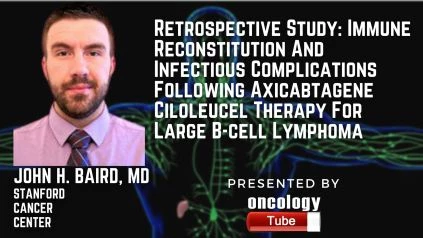John Baird, MD, Fellow in Hematology/Medical Oncology at Stanford Cancer Center speaks about the Retrospective Study: Immune Reconstitution And Infectious Complications Following Axicabtagene Ciloleucel Therapy For Large B-cell Lymphoma.
Link to Article:
https://ashpublications.org/bloodadvances/article/5/1/143/474814/Immune-reconstitution-and-infectious-complications
Points to Remember
* Delayed CD4+ T-cell recovery after CD19-directed CAR T-cell therapy increases the risk of opportunistic infections by up to a year.
* Antimicrobial prophylaxis, immunoglobulin replacement, and growth factor use after axi-cel can help to reduce nonrelapse morbidity and mortality.
Summary
In the treatment of refractory or relapsed large B-cell lymphoma, chimeric antigen receptor (CAR) T-cell therapy targeting CD19 has greatly improved outcomes (LBCL). In 41 patients with LBCL treated with axicabtagene ciloleucel (axi-cel) at a single center, we looked at the long-term path of hematologic regeneration, immune reconstitution, and infectious complications. Grade 3+ cytopenias occurred in 97.6% of patients within the first 28 days after injection, with the majority of cases clearing up by six months. Beyond the first 28 days after infusion, 63.4 percent of patients received a red blood cell transfusion, 34.1 percent received a platelet transfusion, 36.6 percent received IV immunoglobulin, and 51.2 percent of patients received growth factor (granulocyte colony-stimulating factor) injections. By one year, only 40% of patients had regained visible CD19+ B cells, while 50% of patients had a CD4+ T-cell count of 200 cells per L by 18 months. The length of B-cell aplasia was slightly longer in patients who had durable responses to axi-cel, and this duration was closely associated with the regeneration of CD4+ T-cell counts. The first 28 days saw slightly more illnesses than any other time of follow-up, with the rest being mild-moderate in seriousness. In a multivariate study, receiving corticosteroids was the only element that projected infection risk (hazard ratio, 3.69; 95 percent confidence interval, 1.18-16.5). Pneumocystis jirovecii and varicella-zoster virus opportunistic infections occurred up to 18 months after infusion in patients that stopped prophylaxis too soon. These findings encourage the use of intensive preventive care beyond 12 months after axi-cel therapy, including long-term screening and antimicrobial prophylaxis.

